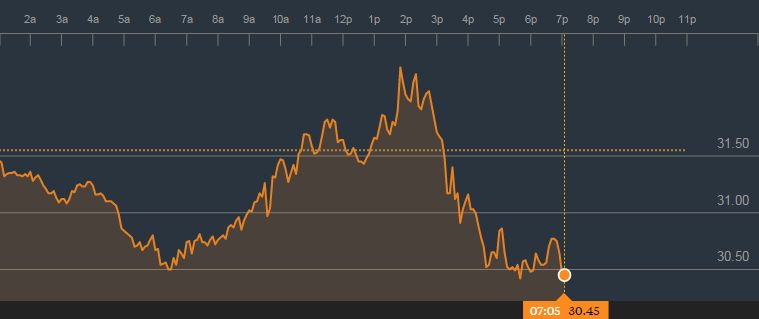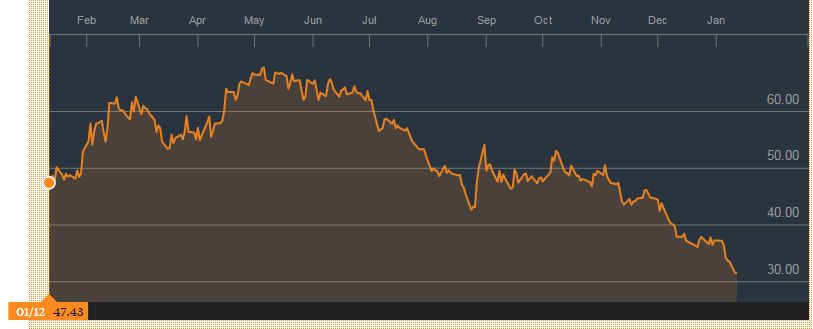Live Updates: The ruble fell to 77 to one US dollar today, the lowest in a year, tied to the fall in the price of Brent crude below $31 for the first time since 2004.
Welcome to our column, Russia Update, where we will be closely following day-to-day developments in Russia, including the Russian government’s foreign and domestic policies.
The previous issue is here.
Recent Translations:
–The Non-Hybrid War
–Kashin Explains His ‘Letter to Leaders’ on ‘Fontanka Office’
–TV Rain Interviews Volunteer Fighter Back from Donbass
–‘I Was on Active Duty’: Interview with Captured GRU Officer Aleksandrov
UPDATES BELOW
The price of a barrel of oil is in a nose dive today. Here is today’s latest on the price of a barrel of Brent Crude from Bloomberg:
In fact, oil briefly fell below $30 a barrel today for the first time in 13 years, and it could go lower. Reuters reports:
Prices firmed early in the day after a deadly suicide bombing rocked central Istanbul, and Nigeria’s oil minister said a “couple” of Organization of the Petroleum Exporting Countries members had requested an emergency meeting.
But they then nosedived anew after the United Arab Emirates oil minister quashed talk of a possible meeting, saying the group strategy was working. OPEC has rejected calls by some of its members to curb output, opting instead to pump full throttle to defend market share rather than shore up prices.
Oil has tumbled more than 18 percent this year alone, the worst seven-day run since the financial crisis. The long list of negative factors also includes the weakening economy and ailing stock market of No. 2 consumer China, the rising U.S. dollar, which makes oil more costly, and the surprising resilience of U.S. shale drillers in the face of the price slide.
Adding to supply fears, Iraq, the second-biggest OPEC producer, plans to export a record of around 3.63 million barrels per day in February, said trade sources.
The Russian ruble has continued to take a heavy hit as a result. Earlier it was trading at 76 to a dollar, 82.41 to a euro. Here’s where it’s at now:
Earlier this morning, when both Brent Crude oil and the ruble were trading higher than they currently are, the economic news forced the Russian government to cut spending. Bloomberg reports:
The government plans to cut fiscal spending by another 10 percent in 2016 as oil trades below the budget forecast of $50 per barrel, Vedomosti reported on Tuesday, saying ministries have been given until Jan. 15 to determine what spending they will reduce. Having the central bank convert “foreign assets” from the Reserve Fund into rubles to finance budget spending would help bolster the local currency, Credit Suisse said.
“Such interventions may help to contain the panic in the currency market before the government reveals the details of its fiscal spending cuts,” Credit Suisse economist Alexey Pogorelov said in an e-mailed report.
The spending cuts are needed because the ruble hasn’t kept up with the drop in oil, meaning the government collects less of the local currency from energy exports.
Societe Generale SA’s Russian unit Rosbank PJSC said Tuesday the “link” between the price of oil and the ruble is weakening as “demand for foreign currency within the country is declining.”
The pressures on the price of oil have been well-documented by the press: China’s economic slowdown (meltdown?), a global drop in demand, and a glut of supply, just to name a few. But since oil trade is priced in US dollars, the world has a new problem — the value of the dollar is high, and could go higher as the Chinese yuan and other currencies are devalued. The dollar is out-competing the euro, the UK pound, the Japanese yen, and currencies from developing economies. A strong dollar will push the price of oil even lower.
CNN reports that analysts at Morgan Stanley predict “a 5% increase in the value of the dollar against a basket of currencies could push oil down by between 10% and 25% — which would mean prices falling by as much as $8 per barrel.”
The report continues:
The International Energy Agency expects the oil market is likely to remain oversupplied throughout 2016. And if the dollar keeps strengthening, it could squeeze prices even further, according to Morgan Stanley.
“Given the continued US [dollar] appreciation, $20-25 oil price scenarios are possible simply due to currency,” the analysts wrote.
As the dollar strengthens, it makes oil more expensive for buyers paying with other currencies. That can weigh on demand and prices.
$20 a barrel could mean exchange rates upwards of 100-110 rubles per dollar, and are certainly a far cry from the $50 a barrel that the Kremlin based its 2016 budget around.
Is there a silver lining for Russia? One theory — devalued currencies help boost exports, since it makes goods cheaper to buy in countries with strong currencies (one reason the Chinese continue to artificially devalue the yuan).
As The Economist points out, however, this does not appear to be happening, as currency devaluation has not provided the same export boost as it used to:
Russia is a good example. Non-energy exporters appear to be struggling despite the rouble’s plunge. Over the first half of 2015, as the volume of energy exports surged, non-energy exports fell, according to Birgit Hansl of the World Bank. She points out that it is not enough to have a price change: “First you have to produce something that someone wants to buy.” The rouble’s weakness is an opportunity for industries that already export, such as chemicals and fertiliser. But boosting other exports requires investment in new production, which takes time.
Another factor not mentioned in that article — Russia is now effectively in a trade war with two major trading partners, Turkey and Ukraine, further hurting the prospects that a boom in Russian exports could save the economy from its current struggles.
— James Miller
Andrei Klishash, head of the committee, wrote to Navalny that because “your appeal does not contain facts testifying to the illegal activity of the prosecutor general,” the material would simply be “noted” under the committee’s rules.
Later Klishash denounced Navalny’s letter to the press as “a purely political story” that has “no proof at all.”
Current law restricts only the minor children of officials from involvement in business; the draft would extend this to spouses and adult children.
The draft law also contains a clause mandating a one-million ruble fine and the dismissal of any official caught hiding assets through fictitious divorces, a sanction likely linked to Navalny’s revelation that Olga Lopatina, the wife of deputy prosecutor Gennady Lopatin, who was found to have registered a business with the wives of organized crime figures, appeared to keep ties with her husband after the couple was divorced. Assets in her name disappeared from his financial disclosure statement.
— Catherine A. Fitzpatrick
The continuing loss of the ruble’s value was tied to the fall of oil prices, with Brent crude going below $31 per barrel to $30.47 for the first time since 2004, RT.com reported.
The ruble has lost more than 50% of its value since 2014.
Currently the ruble is at 76 to a dollar, 82.41 to a euro, and Brent crude is trading at $31.72 per barrel.
— Catherine A. Fitzpatrick

